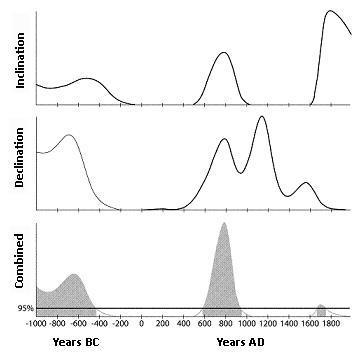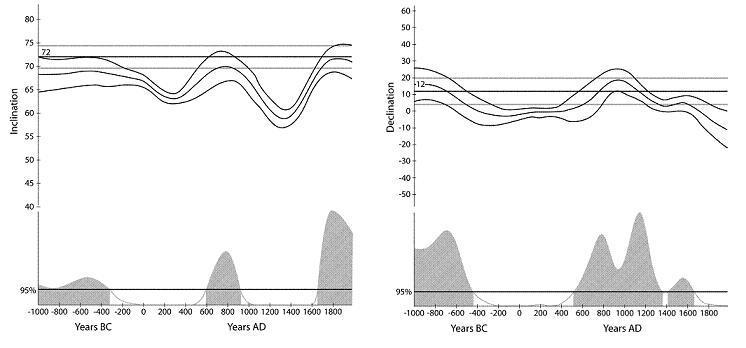Archaeomagnetic Dating
This section covers general information about the archaeomagnetic dating technique, including:
- A summary of the secular variation and calibration curves produced for the UK and the precision available for a calibrated archaeomagnetic date
- The laboratories that carry out archaeomagnetic dating, what they specialise in, and their contact details
- Summaries of the background to the technique, the materials that can be sampled, and examples of sampled features including:
The majority of the information provided here is based on the English Heritage guidelines produced by Paul Linford (2006) 'Archaeomagnetic dating: guidelines on producing and interpreting archaeomagnetic dates', available from http://www.english-heritage.org.uk/upload/pdf/Archaeomagnetic_Dating.pdf?1258026633. Additional references are summarised within the 'Bibliography' section.
Secular Variation and Calibration
A record of how the Earth's magnetic field has changed over time is required to calibrate the measured information from an archaeomagnetic sample into a calendar date. It was first realised that the direction of the Earth's field changes with time in the 16th century, since which time scientists (beginning with Henry Gellibrand) have periodically made observations of the changes in both the declination and inclination at magnetic observatories. The record of how the Earth's magnetic field has changed is referred to as a secular variation curve. The British secular variation curve is based on the observatory data as well as direct measurements from archaeological materials. The Earth's magnetic field is a complicated phenomenon and so it is necessary to develop regional records of secular variation. The regional curves are centred on specific locations; for the UK the central point is located at Meriden (Latitude 52.43°N, Longitude 1.62°W), the village located at the notional centre of England.
Secular variation curves are constantly evolving as new data becomes available. The more information there is, the better we will understand how the Earth's magnetic field has changed over time, which may allow more precise archaeomagnetic dates to be produced. A number of secular variation curves have been produced for Britain over the last 50 years, reflecting the inclusion of additional information as well as improved methods used to construct the curves.
Measurement in the laboratory
The laboratory measurements of the samples are usually carried out using a spinner magnetometer, which determines the direction of the magnetic field recorded within the material. The measurement process can be divided into three stages:
- The initial measurement of the samples determines the natural remanent magnetisation (NRM). This relates to the archaeological signal plus the signal held by less stable magnetic particles, referred to as the viscous component. The less stable component needs to be removed to produce an accurate date for the archaeological event of interest.
- The pilot demagnetisation of a subset of the samples determines information about the stability of the magnetic signal recorded within the material, and identifies the point at which the viscous point is removed from the samples. This is carried out using one of two methods: thermal or alternating field (a.f) demagnetisation.
- The partial demagnetisation of the remaining samples uses the information produced during the pilot study to remove the viscous component from the samples to leave the archaeological signal of interest. The samples can then be re-measured to determine the direction of the archaeological signal recorded by the samples.
This provides the minimum information needed to produce an archaeomagnetic date.
Calibration
The process of calibration translates the measured magnetic vector into calendar years. A record of how the Earth's magnetic field has changed over time is required to do this, and is referred to as a secular variation or a calibration curve. A date is obtained by comparing the mean magnetic vector, defined by the declination and inclination values, with the secular variation curve; the potential age of the sampled feature corresponds to the areas where the magnetic vector overlaps with the calibration curve. Unfortunately, the Earth's magnetic poles have reoccupied the same position on more than one occasion, and can result in multiple age ranges being produced. Alternative chronological information is required in these situations to identify the archaeological significant age range.
The current British secular variation curve was produced by Zananiri et al. (2007) using the RenCurve software developed by Lanos (2004). A calibrated date is obtained using the separate inclination and declination calibration curves. Probability distributions are produced for the calibrated inclination and declination values, before they are statistically combined to produce a single age estimate.
Calibration images
Redrawn by D. Bashford from the graphic outputs produced using the RenDate software (Lanos 2004):
- bellow left - The probability distributions produced for an inclination value of 72 degrees with an alpha-95 value of 3 degrees.
- bellow right - The probability distributions produced for a declination value of 12 degrees with an alpha-95 value of 3 dregrees.
- right - The probability distributions produced for the inclination and declination values are statistically combined (coloured in grey).


Precision
It is difficult to make generalisations about the precision that can be expected from an archaeomagnetic date as the Earth's magnetic field changes at varying rates through time. In periods where the change in direction was rapid, it may be possible to produce a more precise age range, but in the periods where the changes are slower a larger age range may be produced. A related issue is that during the last few millennia the Earth's magnetic poles appear at times to have reoccupied the same position on more than one occasion (for instance during the first centuries BC and AD). This can cause ambiguity as more than one date range is then possible and independent evidence is require to determine which is correct.
The precision available for archaeomagnetic dates calibrated with the RenCurve (Lanos 2004; Zananiri et al. 2007) calibration curves have been summarised in the 'Secular varition and calibration curve' section.
